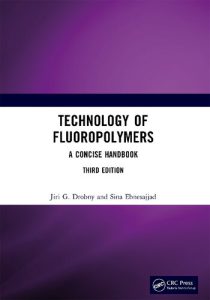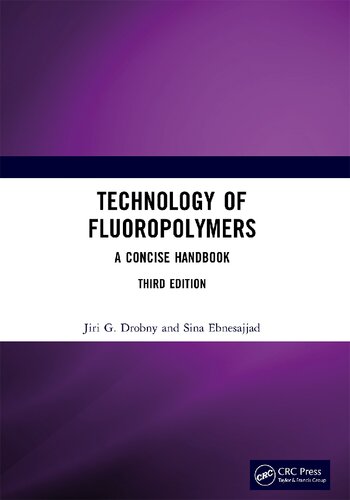Technology of Fluoropolymers A Concise Handbook 3rd Edition by Jiri G. Drobny 9781000839890 1000839893
$50.00 Original price was: $50.00.$25.00Current price is: $25.00.
Technology of Fluoropolymers A Concise Handbook 3rd Edition Jiri G. Drobny – Ebook Instant Download/Delivery ISBN(s): 9781000839890, 1000839893

Product details:
- ISBN 10:1000839893
- ISBN 13:9781000839890
- Author: Jiri G. Drobny
Technology of Fluoropolymers
A Concise Handbook
Table contents:
Part I Overview of Fluoropolymers
1 Introduction
Current Major Manufacturers of Fluoropolymers
References
2 Societal Benefits of Fluoropolymers
2.1 Basic Fluoropolymer Properties
2.2 Examples of Fluoropolymer Applications
2.3 Automotive Applications
2.4 Aerospace Wire and Cable
2.5 Aircraft Fuel Hoses
2.6 Heart Rhythm Management: The Implantable Cardioverter Defibrillator
2.7 Pediatric Heart Repair
2.8 Thread Sealant
2.9 Chemical Processing Industry-lined Pipes, Fittings, and Vessels
2.10 Semiconductor Chip Fabrication
2.11 Biomedical Applications
2.12 PTFE Micropowders
2.13 Applications of Fluoroelastomers in Transportation
2.14 Properties of Thermoplastic Fluoropolymers
2.15 Delving Deeper into Properties
2.16 Forces Affecting the Fluoropolymer Industries
References
Part II Thermoplastic Fluoropolymers
3 Synthesis and Properties of Monomers of Thermoplastic Fluoropolymers
3.1 Preparation of Tetrafluoroethylene
3.2 Properties of Tetrafluoroethylene
3.3 Preparation of Hexafluoropropylene
3.4 Properties of Hexafluoropropylene
3.5 Synthesis of Perfluoroalkylvinylethers
3.6 Properties of Perfluoroalkylvinylethers
3.7 Synthesis of Chlorotrifluoroethylene (CTFE)
3.8 Properties of Chlorotrifluoroethylene
3.9 Synthesis of Vinylidene Fluoride
3.10 Properties of Vinylidene Fluoride
3.11 Synthesis of Vinyl Fluoride
3.12 Properties of Vinyl Fluoride
References
4 Polymerization of Commercial Thermoplastic Fluoropolymers
4.1 Polymerization of Tetrafluoroethylene
4.1.1 Granular Resins
4.1.2 Fine Powder Resins
4.1.3 Aqueous Dispersions
4.1.4 Filled Compounds
4.1.5 Modified PTFE
4.2 Fluorinated Ethylene Propylene
4.2.1 Industrial Process for the Production of FEP
4.3 Perfluoroalkoxy Resin
4.3.1 Industrial Process for the Production of Perfluoroalkoxy Resins
4.4 Polychlorotrifluoroethylene
4.4.1 Industrial Process for the Production of Polychlorotrifluoroethylene
4.5 Polyvinylidene Fluoride
4.5.1 Industrial Process for the Production of Polyvinylidene Fluoride
4.6 Polyvinyl Fluoride
4.6.1 Industrial Process for the Production of Polyvinyl Fluoride
4.7 Ethylene Chlorotrifluoroethylene Copolymer
4.7.1 Industrial Process for the Production of Ethylene Chlorotrifluoroethylene
4.8 Ethylene Tetrafluoroethylene Copolymer
4.8.1 Industrial Process for the Production of Ethylene Tetrafluoroethylene
4.9 Terpolymers of Tetrafluoroethylene, Hexafluoropropylene, and Vinylidene Fluoride (THV Fluoroplastic)
4.10 Terpolymers and Quarterpolymers of Hexafluoropropylene, Tetrafluoroethylene, and Ethylene
References
5 Properties of Commercial Thermoplastic Fluoropolymers
5.1 Properties as Related to the Structure of Fluoropolymers
5.1.1 Fluoroplastics
5.1.1.1 Mechanical Properties
5.1.1.2 Optical Properties
5.1.2 Fluoroelastomers
5.2 Properties of Individual Commercial Fluoroplastics
5.2.1 Polytetrafluoroethylene
5.2.1.1 Molecular Weight
5.2.1.2 Molecular Conformation
5.2.1.3 Crystallinity and Melting Behavior
5.2.1.4 Mechanical Properties
5.2.1.5 Surface Properties
5.2.1.6 Absorption and Permeation
5.2.1.7 Electrical Properties
5.2.2 Modified Polytetrafluoroethylene
5.2.3 Copolymers of Tetrafluoroethylene and Hexafluoropropylene (FEP)
5.2.3.1 Mechanical Properties
5.2.3.2 Electrical Properties
5.2.3.3 Chemical Properties
5.2.3.4 Optical Properties
5.2.3.5 Other Properties
5.2.4 Copolymers of Tetrafluoroethylene and Perfluoroalkyl Ethers (PFA and MFA)
5.2.4.1 Physical and Mechanical Properties
5.2.4.2 Electrical Properties
5.2.4.3 Optical Properties
5.2.4.4 Chemical Properties
5.2.5 Copolymers of Ethylene and Tetrafluoroethylene (ETFE)
5.2.5.1 Structure and Related Properties
5.2.5.2 Mechanical, Chemical, and Other Properties
5.2.6 Polyvinylidene Fluoride (PVDF)
5.2.6.1 Mechanical Properties
5.2.6.2 Electrical Properties
5.2.6.3 Chemical Properties
5.2.7 Polychlorotrifluoroethylene (PCTFE)
5.2.7.1 Thermal Properties
5.2.7.2 Mechanical, Chemical, and Other Properties
5.2.8 Copolymer of Ethylene and Chlorotrifluoroethylene (ECTFE)
5.2.8.1 Properties of ECTFE
5.2.9 Terpolymer of Tetrafluoroethylene, Hexafluoropropylene, and Vinylidene Fluoride (THV Fluoroplastic)
5.2.9.1 Properties
5.2.10 Terpolymer of Ethylene, Tetrafluoroethylene, and Hexafluoropropylene (EFEP)
5.2.11 Polyvinyl Fluoride (PVF)
5.2.11.1 Properties of the PVF Polymer
5.2.11.2 Polyvinyl Fluoride Films and Their Properties
References
6 Processing of Polytetrafluoroethylene Resins
6.1 Processing of Granular Resins
6.1.1 Compression Molding
6.1.1.1 Preforming
6.1.1.2 Sintering
6.1.2 Other Molding Methods
6.1.3 Ram Extrusion
6.2 Processing of Fine Powders
6.2.1 Introduction
6.2.2 Fabrication Methods for Products from Fine Powders
6.2.2.1 Preparation of the Extrusion Mix
6.2.2.2 Preforming
6.2.2.3 Extrusion
6.2.3 Fabrication of Films, Tapes, and Sealing Cords
6.2.3.1 Manufacture of Unsintered Tape
6.2.4 Fabrication of Tubing and Hoses
6.2.4.1 Tube Extrusion
6.2.4.2 Drying and Sintering of Tubes
6.2.5 Fabrication of Thick-Walled Pipes and Liners
6.2.5.1 Liner Extrusion
6.2.5.2 Drying and Sintering the Liner
6.2.6 Fabrication of Wire and Cable Insulation
6.2.6.1 Wire Extruder System
6.2.6.2 Wire Extrusion Process
6.2.6.3 Drying and Sintering of Wire Insulation
6.2.7 Expanded PTFE
6.2.7.1 The Expansion Process
References
7 Fabrication of Melt-Processible Fluoropolymers
7.1 Melt-Processible Perfluoroplastics
7.1.1 Copolymers of Tetrafluoroethylene and Hexafluoropropylene: Fluorinated Ethylene Propylene
7.1.2 Copolymers of Tetrafluoroethylene and Perfluoroalkyl Ethers (PFA and MFA)
7.2 Processing of Other Melt-Processible Fluoroplastics
7.2.1 Copolymers of Ethylene and Tetrafluoroethylene (ETFE)
7.2.2 Polyvinylidene Fluoride (PVDF)
7.2.3 Polychlorotrifluoroethylene (PCTFE)
7.2.4 Copolymers of Ethylene and Chlorotrifluoroethylene (ECTFE)
7.2.5 Terpolymers of Tetrafluoroethylene, Hexafluoropropylene, and Vinylidene Fluoride (THV Fluoroplastics)
7.2.6 Terpolymer of Ethylene, Tetrafluoroethylene, and Hexafluoropropylene: (EFEP)
References
8 Applications of Commercial Thermoplastic Fluoropolymers
8.1 Applications of PTFE and Modified PTFE
8.2 Applications of FEP
8.3 Applications of PFA and MFA
8.4 Applications of ETFE
8.5 Applications of PVDF
8.6 Applications of PCTFE
8.7 Applications of ECTFE
8.8 Applications of THV Fluoroplastics
8.9 Applications of EFEP
8.10 Applications of PVF
8.10.1 Aircraft Interiors
8.10.2 Architectural Applications
8.10.3 Graphic Applications
8.10.4 Solar Applications
References
Part III Fluoroelastomers
9 Fluorocarbon Elastomers
9.1 Manufacturing Process for Fluorocarbon Elastomers
9.1.1 Industrial Synthesis of Monomers for Fluorocarbon Elastomers
9.1.2 Polymerization and Finishing of Fluorocarbon Elastomers
9.1.2.1 Emulsion Polymerization
9.1.2.2 Suspension Polymerization
9.2 Properties of Fluorocarbon Elastomers
9.2.1 Properties Related to the Polymer Structure
9.2.2 Other Properties
9.2.3 Properties of Currently Available Commercial Fluorocarbon Elastomers
9.2.3.1 FKM Type 1: Copolymers of HFP and VDF
9.2.3.2 FKM Type 2: Terpolymers of TFE, VDF, and HFP
9.2.3.3 FKM Type 3: Terpolymers of TFE, PMVE, and VDF
9.2.3.4 FKM Type 4: Terpolymers of TFE, P, and VDF
9.2.3.5 FKM Type 5: Pentapolymers of TFE, HFP, VDF, Ethylene, and PMVE
9.2.3.6 FFKM Perfluoroelastomers
9.2.3.7 FEPM
9.3 Fabrication Methods for Fluorocarbon Elastomers
9.3.1 Mixing and Processing of Compounds from Fluorocarbon Elastomers
9.3.1.1 Mixing of Compounds of Fluorocarbon Elastomers
9.3.1.2 Processing of Fluorocarbon Elastomers
9.3.2 Curing of Fluorocarbon Elastomers
9.3.2.1 Cross-Linking Chemistry
9.3.2.2 Molding Processes
9.3.3 Post-Curing Process
9.4 Physical and Mechanical Properties of Cured Fluorocarbon Elastomers
9.4.1 Heat Resistance
9.4.2 Compression Set Resistance
9.4.3 Low-Temperature Flexibility
9.4.4 Resistance to Automotive Fuels
9.4.5 Resistance to Solvents and Chemicals
9.4.6 Steam Resistance
9.5 Formulation of Compounds of Fluorocarbon Elastomers
9.5.1 Fillers
9.5.2 Acid Acceptor Systems
9.5.3 Curatives
9.5.4 Plasticizers and Processing Aids
9.6 Applications of Fluorocarbon Elastomers
9.6.1 Applications of FKMs
9.6.1.1 Typical Automotive Applications
9.6.1.2 Typical Aerospace and Military Applications
9.6.1.3 Typical Chemical and Petrochemical Applications
9.6.1.4 Other Industrial Applications
9.6.2 Applications of FFKMs
9.6.3 Applications of FEPM
9.6.4 Applications of FKMs in Coatings and Sealants
9.6.5 Applications of FKMs as Polymeric Processing Additives
9.7 Examples of Fluorocarbon Elastomer Formulations
9.7.1 Typical Formulations of Fluoroelastomer Compounds
9.7.2 Rotary Seal for Airborne Applications
9.7.3 Compounds for Compression Molded Seals
9.7.4 Basic O-Ring Compounds
9.7.5 Compound for Closed Cell Sponge
9.7.6 Example of Compounds Based on FEPM (TFE/P) Elastomers
9.7.7 Example of Steam Resistant Formulations
9.7.8 Basic Extrusion Compounds
9.7.9 Example of FKM Compounds for Aerospace AMS 3216 and AMS 7276H
9.7.10 No Post-Cure Fluoroelastomer Articles
9.7.11 Low Temperature Service Seals
9.7.12 FFKM Compound for Aerospace-AMS 7257E
9.8 Fluoroelastomer Safety, Disposal, and Sustainability
9.8.1 Safety in Production
9.8.2 Safety in Applications
9.8.3 Disposal
9.8.4 Sustainability
References
10 Fluorinated Thermoplastic Elastomers
10.1 Introduction
10.2 Types of Fluorinated Thermoplastic Elastomers
10.3 Methods to Produce Fluorinated Thermoplastic Elastomers
10.4 Commercial Fluorinated Thermoplastic Elastomers and Their Properties
10.5 Applications of Fluorinated Thermoplastic Elastomers
10.5.1 Chemical and Semiconductor Industries
10.5.2 Electrical, and Wire and Cable
10.5.3 Other Applications
References
11 Fluoro-Inorganic Elastomers
11.1 Fluorosilicone Elastomers
11.1.1 Introduction
11.1.2 Polymerization Process for Fluorosilicone Elastomers
11.1.3 Processing of Fluorosilicone Elastomers and Compounds
11.1.4 Properties of Fluorosilicone Elastomer Compounds
11.1.4.1 Fluid and Chemical Resistance
11.1.4.2 Heat Resistance
11.1.4.3 Low Temperature Behavior
11.1.4.4 Electrical Properties
11.1.4.5 Surface Properties
11.1.5 Applications of Fluorosilicone Compounds
11.1.6 Fluorosilicone Liquid Systems
11.1.7 Toxicity and Safety
11.2 Polyphosphazene Elastomers
11.2.1 Introduction
11.2.2 Fluorinated Polyhosphazene Elastomers
11.2.2.1 Preparation
11.2.2.2 Properties
11.2.2.3 Applications
References
Part IV Technology of Fluoropolymer Aqueous Systems
12 Characteristics and Properties of Fluoropolymer Aqueous Systems
12.1 PTFE Dispersions and Coatings
12.1.1 PTFE Aqueous Dispersions
12.1.2 PTFE Industrial Coatings
12.2 Other Perfluoroplastic Dispersions and Coatings
12.2.1 FEP Dispersions
12.2.2 FEP Industrial Coatings
12.2.3 PFA/MFA Dispersions and Coatings
12.2.3.1 PFA/MFA Dispersions
12.2.3.2 PFA Industrial Coatings
12.2.4 Modified PTFE Dispersions
12.2.5 Dispersions of PTFE Micropowders
12.3 Other Fluoroplastic Dispersions
12.3.1 Dispersions of PVDF
12.3.2 Dispersions of THV Fluoroplastics
12.4 Fluorocarbon Elastomers in Latex Form
References
13 Processing and Applications of Fluoropolymer Aqueous Systems
13.1 Introduction
13.2 Processing and Applications of PTFE Dispersions
13.2.1 Impregnation
13.2.2 Fabric Coating
13.2.2.1 Equipment
13.2.2.2 Formulations
13.2.2.3 Coating Process
13.2.2.4 Lamination
13.2.2.5 Applications of PTFE Coated Fabrics
13.2.3 Cast Films
13.2.3.1 Process and Equipment
13.2.3.2 Applications of PTFE Cast Films
13.2.4 Processing and Applications of Modified PTFE Dispersions
13.2.5 Processing and Applications of PTFE Micropowders
13.2.5.1 Addition to Paints
13.2.5.2 Addition to Elastomers
13.2.5.3 Addition to Oils and Greases
13.2.6 Other Processing and Applications of PTFE Aqueous Dispersions
13.3 Processing and Applications of Other Fluoropolymer Aqueous Systems
13.3.1 Aqueous Dispersions of FEP and PFA/MFA
13.3.2 Aqueous Dispersions of PVDF
13.3.3 Aqueous Dispersions of THV Fluoroplastics
13.3.4 Fluorocarbon Elastomers in Latex Form
13.4 Health and Safety
References
Part V Other Fluoropolymers
14 Specialty Fluorinated Polymers
14.1 Amorphous Fluoropolymers
14.2 Fluorinated Acrylates
14.3 Fluorinated Polyurethanes
14.4 Fluorinated Thermoplastic Elastomers
14.5 Copolymers of Chlorotrifluoroethylene and Vinyl Ether
14.6 Perfluorinated Ionomers
References
15 Applications of Specialty Fluorinated Polymers
15.1 Applications of Amorphous Perfluoropolymers
15.2 Applications of Fluorinated Acrylates
15.2.1 Textile Finishes
15.2.2 Optical Fibers
15.2.3 Other Applications
15.3 Applications of Fluorinated Polyurethanes
15.3.1 Surface Coatings
15.3.2 Solvent-Based Coatings
15.3.3 Water-Based Coatings
15.3.4 Powder Coatings
15.3.5 Treatments of Textile, Leather, and Other Substrates
15.3.6 Medical and Dental Applications
15.3.7 Cladding for Optical Fibers
15.3.8 Elastomers
15.3.9 Other Applications
15.4 Applications of Fluorinated Thermoplastic Elastomers
15.5 Applications of Copolymers of CTFE and Vinyl Ether
15.6 Applications of Perfluorinated Ionomers
References
Part VI Effects of Temperature and Other Variables on Fluoropolymers
16 Effect of Temperature on Fluoropolymers
16.1 Introduction
16.2 Thermal Stability of PTFE
16.3 Thermal Stability of Perfluorinated Copolymers of Tetrafluoroethylene
16.3.1 Fluorinated Ethylene Propylene Copolymer (FEP)
16.3.2 Thermal Stability of PFA
16.3.3 Thermal Stability of ETFE
16.3.4 Thermal Stability of ECTFE
16.3.5 Thermal Stability of PCTFE
16.3.6 Thermal Stability of PVDF
References
17 The Effect of the Environment on Fluoropolymers
17.1 Introduction
17.2 Polytetrafluoroethylene (PTFE)
17.3 Perfluorinated Copolymers of Tetrafluoroethylene
17.3.1 PFA and MFA
17.3.2 FEP
17.4 Ethylene Tetrafluoroethylene Copolymer
17.5 Polyvinylidene Fluoride (PVDF)
17.6 Polychlorotrifluoroethylene (PCTFE)
17.7 Ethylene Chlorotrifluoroethylene Copolymer (ECTFE)
17.8 Polyvinyl Fluoride (PVF)
References
18 The Effect of Radiation on Fluoropolymers
18.1 Introduction
18.2 Effects of Ionizing Radiation on Fluoroplastics
18.2.1 Effects of Ionizing Radiation on Perfluoroplastics
18.2.2 Effects of Ionizing Radiation on Other Fluoroplastics
18.3 Effects of Ionizing Radiation on Fluorocarbon Elastomers
18.3.1 Effects of Ionizing Radiation on the FKM Type of Fluorocarbon Elastomers
18.3.2 Effects of Ionizing Radiation on Perfluoroelastomers
18.3.3 Effects of Ionizing Radiation on TFE/P Elastomers
18.4 Effects of Ionizing Radiation on Fluorosilicone Elastomers
18.5 Effects of UV Radiation on Fluoropolymers
References
Part VII Safety and Sustainability
19 Safety Aspects of Fluoropolymers
19.1 Introduction
19.2 Fluoropolymers: The Essential Plastic
19.3 Polymerization Aids
19.3.1 Replacement of Polymerization Aids
19.4 Tetrafluoroethylene
19.5 Toxicology of Fluoropolymers
19.6 Emissions During Processing
19.7 Polymer Fume Fever (PFF)
19.8 Fluoropolymer Dispersions
19.9 Hygiene and Personal Protective Equipment
References
20 Recycling, Reuse, and Disposal of Fluoropolymers
20.1 Introduction
20.2 Fluorine Ore: Fluorspar
20.3 Melt Processible Fluoropolymers
20.4 Polytetrafluoroethylene (PTFE)
20.5 PTFE Scrap Sources for Recycling
20.6 Routes to the Reuse of Polytetrafluoroethylene
20.6.1 Virgin PTFE
20.6.2 Physical Processing: Recycling
20.6.3 Physical Processing: Reprocessing
20.7 Disposal of Fluoropolymers
20.8 Chemical Recycling (“Upcycling”)
People also search:
technology of fluoropolymers
technology of fluoropolymers a concise handbook
what is phytorid technology
what is photomask technology
fluoro-polymers
You may also like…
Medicine - Veterinary Medicine
Concise Textbook of Large Animal Handling: A Practical Handbook C.B. Chastain
History - Latin American History
History - European History
A Concise History of France 3rd Edition by Roger Price ISBN 9781107720459 1107720451
Medicine
Neurological Clinical Examination: A Concise Guide 3rd Edition by Morris 9781138453760 1138453765
Biology and other natural sciences - Ecology
How to Do Ecology A Concise Handbook 3rd Edition Richard Karban
History - European History
A Concise History of Portugal 3rd Edition by David Birmingham ISBN 1108337465 9781108337465
Education Studies & Teaching - School Education & Teaching












